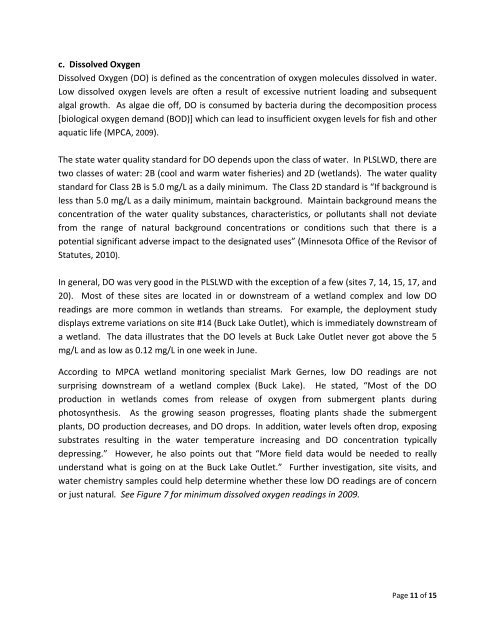Prior Lake - Spring Lake Watershed District 2009 Water Quality ...
Prior Lake - Spring Lake Watershed District 2009 Water Quality ...
Prior Lake - Spring Lake Watershed District 2009 Water Quality ...
You also want an ePaper? Increase the reach of your titles
YUMPU automatically turns print PDFs into web optimized ePapers that Google loves.
c. Dissolved OxygenDissolved Oxygen (DO) is defined as the concentration of oxygen molecules dissolved in water.Low dissolved oxygen levels are often a result of excessive nutrient loading and subsequentalgal growth. As algae die off, DO is consumed by bacteria during the decomposition process[biological oxygen demand (BOD)] which can lead to insufficient oxygen levels for fish and otheraquatic life (MPCA, <strong>2009</strong>).The state water quality standard for DO depends upon the class of water. In PLSLWD, there aretwo classes of water: 2B (cool and warm water fisheries) and 2D (wetlands). The water qualitystandard for Class 2B is 5.0 mg/L as a daily minimum. The Class 2D standard is “If background isless than 5.0 mg/L as a daily minimum, maintain background. Maintain background means theconcentration of the water quality substances, characteristics, or pollutants shall not deviatefrom the range of natural background concentrations or conditions such that there is apotential significant adverse impact to the designated uses” (Minnesota Office of the Revisor ofStatutes, 2010).In general, DO was very good in the PLSLWD with the exception of a few (sites 7, 14, 15, 17, and20). Most of these sites are located in or downstream of a wetland complex and low DOreadings are more common in wetlands than streams. For example, the deployment studydisplays extreme variations on site #14 (Buck <strong>Lake</strong> Outlet), which is immediately downstream ofa wetland. The data illustrates that the DO levels at Buck <strong>Lake</strong> Outlet never got above the 5mg/L and as low as 0.12 mg/L in one week in June.According to MPCA wetland monitoring specialist Mark Gernes, low DO readings are notsurprising downstream of a wetland complex (Buck <strong>Lake</strong>). He stated, “Most of the DOproduction in wetlands comes from release of oxygen from submergent plants duringphotosynthesis. As the growing season progresses, floating plants shade the submergentplants, DO production decreases, and DO drops. In addition, water levels often drop, exposingsubstrates resulting in the water temperature increasing and DO concentration typicallydepressing.” However, he also points out that “More field data would be needed to reallyunderstand what is going on at the Buck <strong>Lake</strong> Outlet.” Further investigation, site visits, andwater chemistry samples could help determine whether these low DO readings are of concernor just natural. See Figure 7 for minimum dissolved oxygen readings in <strong>2009</strong>.Page 11 of 15




